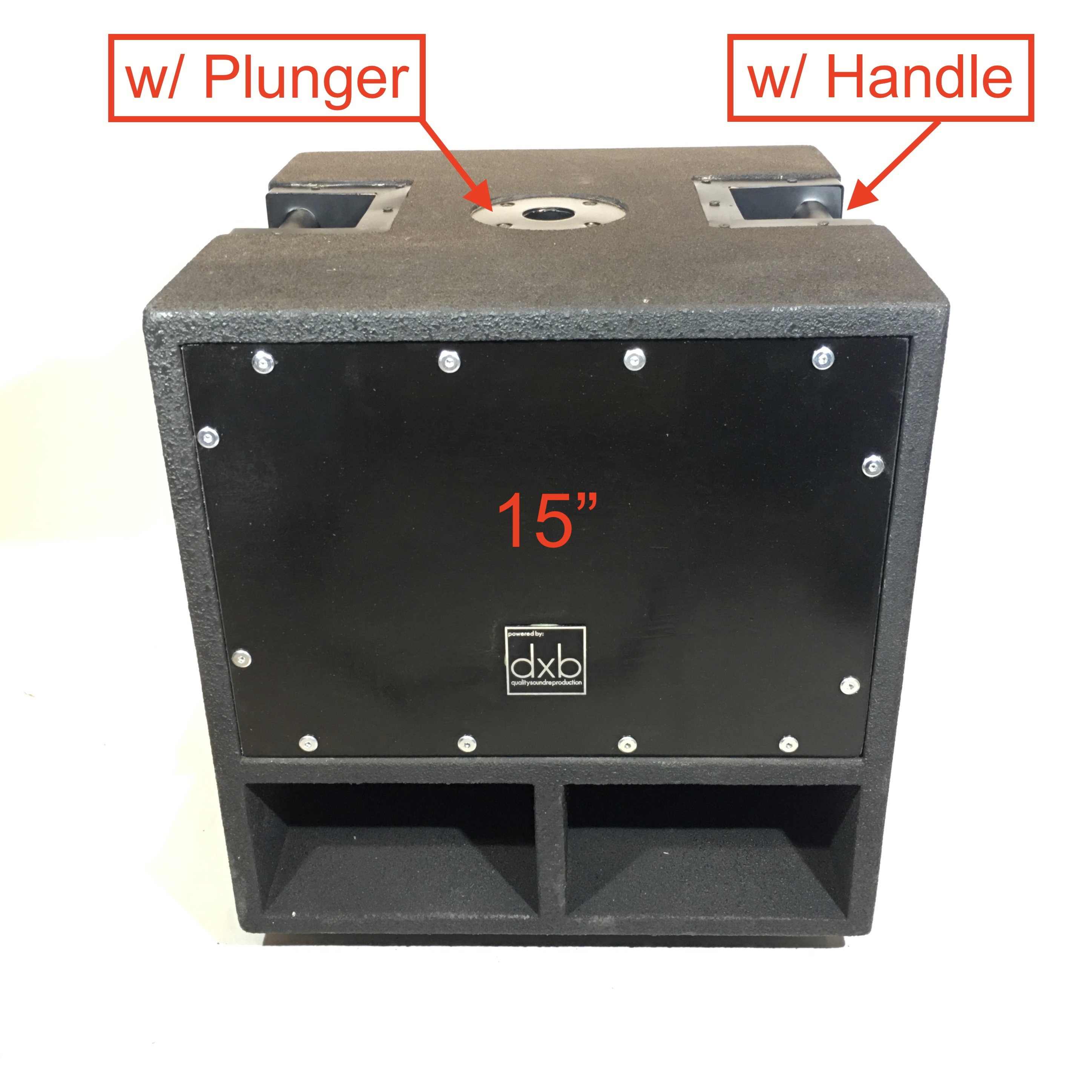PA Subwoofer Cabinet Design Fundamentals

Designing a subwoofer cabinet is a crucial aspect of achieving high-quality low-frequency reproduction in a sound reinforcement system. The cabinet’s design directly impacts the subwoofer driver’s performance, influencing factors such as efficiency, frequency response, and overall sound quality. Understanding the fundamental acoustic principles involved is essential for creating a well-performing subwoofer.
Acoustic Principles of Subwoofer Cabinet Design
The primary goal in subwoofer cabinet design is to control the movement of air produced by the driver’s cone. This air movement, or acoustic energy, is responsible for generating the low-frequency sounds we hear. The cabinet’s internal volume, port design (if applicable), and bracing all influence how efficiently this energy is transferred to the listening environment. Factors such as cabinet resonances and internal reflections can negatively impact sound quality, leading to muddy bass or unwanted coloration. Therefore, careful consideration of these factors is paramount to achieving optimal performance. The stiffness and damping properties of the cabinet materials also play a crucial role in minimizing unwanted vibrations and resonances.
Subwoofer Enclosure Types
Different types of subwoofer enclosures offer varying advantages and disadvantages concerning low-frequency extension, efficiency, transient response, and overall size.
| Enclosure Type | Low Frequency Extension | Efficiency | Transient Response | Size |
|---|---|---|---|---|
| Sealed (Acoustic Suspension) | Moderate | Low | Excellent | Relatively Small |
| Ported (Bass Reflex) | Extended | High | Good | Larger than Sealed |
| Bandpass | Variable, depending on design | High (in specific frequency range) | Moderate | Large |
| Horn | Extended, highly directional | Very High | Variable, can be slow | Very Large |
Calculating Internal Volume, Pa subwoofer cabinet design
Calculating the internal volume of a subwoofer cabinet is crucial for proper driver integration. This calculation is based primarily on the driver’s parameters, specifically its Vas (equivalent compliance volume). Vas represents the volume of air that has the same stiffness as the driver’s suspension. A common rule of thumb for a sealed enclosure is to aim for an internal volume approximately equal to the driver’s Vas value. However, this is just a starting point; optimum performance may require adjustments based on listening preferences and specific application requirements. For more complex designs like ported or bandpass enclosures, more sophisticated calculations are needed, often involving specialized software or online calculators. The calculation involves considering the desired tuning frequency and other driver parameters to achieve optimal performance.
Sealed Subwoofer Enclosure Design
Let’s design a basic sealed enclosure for a 12-inch subwoofer driver with the following specifications: Vas = 5 cubic feet, Fs (resonant frequency) = 30 Hz. We’ll aim for an internal volume of approximately 5 cubic feet.
To achieve this volume, we can design a rectangular enclosure with the following dimensions:
* Width: 24 inches
* Depth: 20 inches
* Height: 12 inches
This results in an internal volume of approximately 5 cubic feet (24 x 20 x 12 inches / 1728 cubic inches/cubic foot ≈ 5 cubic feet). The cabinet will be constructed from 3/4-inch thick MDF (Medium-Density Fiberboard) for its stiffness and damping properties. Appropriate bracing will be added internally to further reinforce the structure and minimize unwanted vibrations. The front baffle will be designed to accommodate the 12-inch driver, and appropriate porting or bracing will be incorporated based on the specific driver requirements. The final design will require precise measurements and careful construction to minimize air leaks and ensure optimal performance. Appropriate finishing materials, such as paint or vinyl wrap, can be applied to protect the cabinet and enhance its aesthetic appeal. Remember that these dimensions are a starting point and may need adjustments based on real-world constraints and driver specifications. For a more accurate design, using specialized subwoofer design software is highly recommended.
Advanced PA Subwoofer Cabinet Design Techniques

Moving beyond the fundamentals, we delve into advanced techniques crucial for achieving optimal subwoofer performance. These techniques involve careful consideration of various design parameters and the utilization of sophisticated tools to minimize unwanted effects and maximize efficiency. Mastering these aspects will significantly elevate the quality and power of your subwoofer system.
Port Tuning and Bracing Impact on Subwoofer Performance
Port tuning significantly impacts the subwoofer’s low-frequency response. A properly tuned port enhances the output at the resonant frequency, creating a smoother, more extended bass response. However, improper tuning can lead to a peaky response, unwanted resonance, and even port noise. Bracing, on the other hand, is critical for maintaining cabinet rigidity and minimizing unwanted vibrations. A poorly braced cabinet will resonate at various frequencies, muddying the sound and reducing efficiency. The interplay between port tuning and bracing is crucial; a well-braced cabinet will better maintain the intended port tuning characteristics. For example, a subwoofer with a poorly braced cabinet might exhibit a resonant frequency significantly different from the design goal, resulting in a weak or uneven bass response. Careful consideration of both port dimensions and internal bracing patterns is essential for optimizing performance.
Finite Element Analysis (FEA) for Cabinet Optimization
Finite Element Analysis (FEA) software provides a powerful tool for optimizing cabinet design and minimizing unwanted resonances. FEA simulates the cabinet’s behavior under various conditions, allowing designers to identify and mitigate potential issues before prototyping. The software models the cabinet’s structure as a collection of interconnected elements, allowing for precise analysis of stress, strain, and vibration modes. By analyzing the results, designers can optimize the cabinet’s bracing, material thickness, and overall shape to minimize unwanted resonances and improve overall structural integrity. For example, FEA might reveal areas of high stress concentration in a cabinet design, allowing for reinforcement in those specific areas to prevent failure or unwanted vibrations. This iterative process of design and analysis leads to a more robust and efficient subwoofer cabinet.
Comparison of Subwoofer Cabinet Materials
Several materials are commonly used for subwoofer cabinet construction, each with its own advantages and disadvantages. Plywood offers excellent stiffness and damping properties, making it a popular choice for high-performance subwoofers. MDF (Medium-Density Fiberboard) is another common choice, providing good stiffness at a lower cost than plywood. However, MDF is generally less damped than plywood. Particle board, while the least expensive option, offers significantly lower stiffness and damping, leading to increased cabinet resonance and reduced sound quality. The choice of material often involves a trade-off between cost, performance, and ease of construction. For example, a high-end subwoofer might utilize Baltic birch plywood for its superior stiffness and damping, while a budget-conscious design might opt for MDF.
Flared Port Design for a Ported Subwoofer Cabinet
This design incorporates a flared port to reduce port noise. The flared port gradually increases in diameter from the cabinet to the outside, reducing air velocity and thus minimizing turbulence and noise.
[Diagram: A cross-sectional view of the ported subwoofer cabinet. The cabinet is rectangular with internal bracing visible. The port is clearly shown, flaring outwards from the cabinet. Dimensions are labelled: internal volume (e.g., 5 cubic feet), port length (e.g., 12 inches), port entrance diameter (e.g., 4 inches), port exit diameter (e.g., 6 inches), and overall cabinet dimensions (e.g., 24″ x 24″ x 18″). Material: 3/4″ thick MDF. Bracing: Internal cross-bracing is strategically placed to reinforce the cabinet structure, minimizing vibrations and resonances. The bracing pattern should be clearly shown in the diagram.]
[Specifications: A table summarizing the key specifications of the subwoofer cabinet. This would include dimensions (length, width, height, internal volume), port dimensions (length, entrance diameter, exit diameter), material type, bracing details, and estimated tuning frequency (e.g., 35 Hz).]
Practical Considerations and Refinements in PA Subwoofer Cabinet Design

Building a high-performance PA subwoofer cabinet requires meticulous attention to detail beyond just the theoretical design. The practical aspects of construction, material selection, and finishing significantly impact the final product’s sound quality, durability, and overall performance. Careful consideration of these factors is crucial for achieving optimal results.
Cabinet Construction Techniques
Proper construction techniques are paramount for a robust and acoustically sound subwoofer cabinet. The choice of joining methods directly affects the cabinet’s structural integrity and ability to withstand the pressures generated by the subwoofer driver. Using high-quality wood such as Baltic birch plywood is recommended for its strength, stiffness, and resistance to moisture. For joining, robust methods like dado and rabbet joints, reinforced with wood glue and screws, offer superior strength compared to simple butt joints. Additionally, the use of biscuits or dowels can further enhance joint strength and alignment. The internal bracing significantly impacts the cabinet’s resonance and vibration characteristics. Poorly constructed joints will lead to leaks, compromising the acoustic performance and potentially causing damage to the driver. A well-constructed cabinet, on the other hand, provides a stable and resonant-free environment for the driver to operate efficiently.
Finishing and Airtight Seals
Applying a durable and aesthetically pleasing finish protects the cabinet from environmental factors like moisture and impacts. Multiple coats of paint or a durable veneer not only enhance the appearance but also provide a protective barrier. Equally important is creating airtight seals at all joints and seams. This prevents air leaks that can significantly reduce the subwoofer’s low-frequency output and introduce unwanted resonances. Wood filler can be used to smooth out imperfections and gaps before applying the finish. A high-quality sealant, applied meticulously, ensures an airtight seal. Careful attention to these details significantly improves the cabinet’s performance and longevity. Failure to achieve airtight seals can result in a noticeable reduction in low-frequency response and overall sound quality.
Internal Bracing Optimization
Strategic placement of internal bracing is essential for minimizing unwanted cabinet vibrations and maximizing structural rigidity. Excessive vibration can lead to a muddy or distorted bass response. The goal is to stiffen the cabinet’s panels and prevent them from flexing under the pressure of the subwoofer driver.
- Cross-bracing: X-shaped bracing across the largest panels effectively resists flexing and distributes stress evenly. The bracing should be securely attached using wood glue and screws, ensuring a strong and rigid connection.
- Internal supports: Vertical and horizontal supports along the cabinet’s internal walls add extra rigidity and help to reinforce the joints. These should be strategically placed to maximize their effectiveness.
- Corner bracing: Reinforcing the cabinet’s corners with additional wood blocks or angled bracing significantly increases overall strength and reduces vibration at these critical points. The choice of bracing material should match or exceed the strength of the cabinet’s main material.
Addressing Potential Construction Problems
Several issues might arise during construction. Wood warping, for example, can be minimized by acclimating the wood to the workshop environment before cutting. If warping occurs, careful clamping and application of moisture-resistant sealant can help to correct it. Uneven surfaces can be addressed with careful sanding and filling. Inconsistent glue application can lead to weak joints; therefore, applying a generous but even amount of glue is essential. Finally, incorrect measurements or cuts can compromise the overall structure. Precise measurement and careful cutting techniques using appropriate tools are essential to avoid these problems. Addressing these issues promptly ensures a high-quality finished product.
